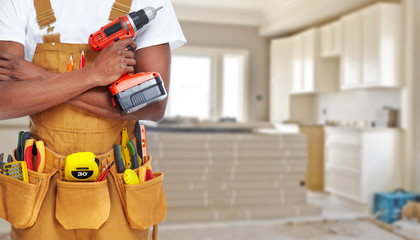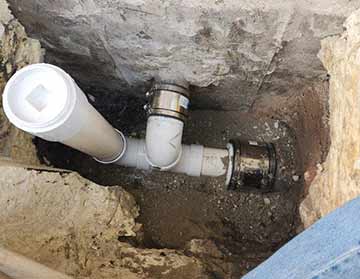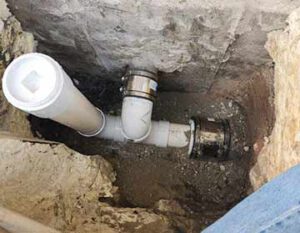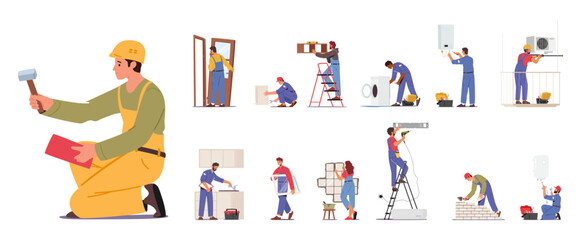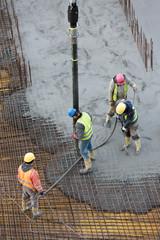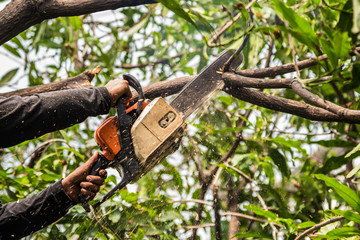Handyman is a jack of all trades and offers customers the versatility that plumbers, electricians, and similar professionals cannot. They are in demand throughout and can provide an excellent income.

A good handyman is equipped with the best tools to get the job done right. These include a utility knife, spirit level, and nail gun.
A handyman is skilled in various trades and can complete maintenance and repair tasks in both residential and commercial settings. Standard plumbing jobs include repairing or replacing broken taps, installing sinks and toilets, and fixing leaks. When the work is more intricate, a handyman can recommend a plumber or professional electrician to provide specialist services.
While most states do not require a license to perform maintenance and repair tasks, many have regulations in place that limit the type of work that a jack-of-all-trades can complete without a licensed contractor. These limitations are sometimes called “handyman exemptions” and can define the scope of work that a jack-of-all-trades may legally undertake.
Many handymen are self-employed and operate their own business, while others work as part of a team of professionals. Those who work for service companies or construction firms usually report into an office or facilities manager. They often work with other workers such as carpenters, general labourers and electrical or building systems engineers.
Some handymen are also trained plumbers, while others specialize in specific trades. Generally, a plumber will charge more than a handyman, but they are better qualified to carry out complex plumbing jobs. For example, a plumber is more likely to be able to fix a clogged or leaky toilet and may have access to high-tech equipment that allows them to carry out video inspections to determine the source of the problem.
Most handymen will not be able to work on gas lines, even though they may have some plumbing experience. Working on gas lines requires special licensing, so it is important to find a reputable plumber for any job that involves the installation or repair of a gas line.
If you are unsure whether a particular job should be completed by a plumber or a handyman, it is always best to get several quotes from both parties before hiring someone. This will ensure that you are getting a fair price for the work and that you are not being overcharged. It is also a good idea to ask for references and examples of previous jobs before making a decision.
Electrical
Generally speaking, Handymen are capable of performing various electrical jobs including replacing light bulbs and switches. They may also be able to rewire sockets and install alarms, doorbells, security cameras and thermostats. However, more complex electrical work should only be completed by licensed electricians to avoid any potential hazards.
In addition to replacing lighting fixtures and switches, a Handyman can also help with the installation of new outlets and ceiling fans. They can even run cable lines between rooms for televisions and other electronic devices. They are able to troubleshoot many electrical wiring issues such as faulty breakers, fuses and tripped circuits. They can also check the amperage draw of an appliance to ensure it is not overloading a particular circuit.
Handymen are also skilled at installing smoke detectors to help protect their clients’ homes. They can install the detectors and make sure they are grounded and wired correctly according to local laws and regulations. Additionally, they can ensure the batteries are fresh and replace them as needed.
Most states require Handymen to have a trade-specific license in order to perform plumbing, electrical and HVAC services. However, there are some states that don’t require a license in order to provide these services. Even if your state doesn’t have any restrictions, it is best to only hire Handymen who have extensive experience in these fields.
As a general rule, it’s better to hire a professional for any electrical, plumbing and HVAC jobs rather than trying to save money by hiring a less experienced worker. This will prevent any potential problems in the future and ensure the job is done properly and safely. Also, it’s important for the client to understand that attempting DIY electrical and plumbing tasks is dangerous and should only be left to licensed professionals. This will help to keep everyone safe while saving the client money. Fortunately, there are plenty of skilled Handymen available to help with any home maintenance and repair needs. Just remember to do your homework before hiring one to get the best results. You can always ask friends and family members for recommendations.
Painting
Handymen are skilled professionals who can tackle a variety of tasks in various settings. They work in residential and commercial settings, doing small jobs that don’t require a licensed professional to complete. Some handymen are self-employed, while others work for a service company and travel to different locations across multiple sites.
The most common work is carpentry and painting services. Handymen can install cabinets, doors, countertops, and flooring including tiles, carpets, and hardwood and laminate coverings. They can also repair damaged walls and ceilings. They can even install and replace windows. They can perform basic plumbing repairs, such as replacing taps and toilets. They can also clean up gutters and down pipes, patch leaks, and rewire sockets. They can even install and repair alarms, doorbells, security cameras, thermostats, and smoke detectors.
Other than flooring, another common handyman task is tile installation and laying. This can be tricky because if the tiles aren’t laid properly, they can crack and become discolored. Tile installers use specialized tools and methods to make sure the tiles look great when finished. This is a skill that many people don’t have, so hiring a professional to do the job is a good idea.
One of the most popular services offered by Handymen is painting, both interior and exterior. Many people need handyman painting contractors for a number of reasons. A fresh coat of paint can brighten a room, and it can also help to increase the value of your home or office. A professional painting contractor will also use high-durability coatings that are designed to last for a long time.
Many homeowners and property managers turn to Handymen for interior painting services, especially if the home is occupied. Some Handymen even specialize in painting services because they are so popular. They can handle both residential and commercial properties and will often have the appropriate tools for the job, such as a ladder, drop cloths, tape, furniture covers, and more.
Painting a room is a big project that requires a lot of skill and precision. Hiring a professional is the best way to ensure that your Handyman’s painting job looks excellent. The price of a Handyman’s painting services will vary depending on the type and size of the room and how much preparation is needed, such as patching holes and cracks, sanding, and priming surfaces before painting. The cost will also depend on the type of paint used; higher-quality paints may be more expensive but can last longer and look better than cheaper paints.
Flooring
A handyman is a professional that handles a wide range of home improvement projects. They typically charge by the hour and may negotiate a flat rate for larger jobs. Their services include pressure washing, gutter cleaning, furniture assembly, sink or window repair, picture hanging, painting, and some flooring work. They may also provide plumbing and electrical services. They often have a license and insurance, but do not require a formal education in their trade. They are best suited for smaller, less complicated jobs than a contractor.
Tile floors are a common choice for kitchens, bathrooms, and hallways. They are attractive, easy to clean, and durable. However, regular foot traffic can cause them to chip or crack. A handyman can fix these problems quickly and easily, making your tile look new again.
Whether they’re a new purchase or old family heirloom, damaged doors are a major eyesore. Handymen can often make quick repairs to get your door functioning properly again. They can repair hinges and hardware, or if the damage is severe, they may need to remove the door and replace the damaged parts.
Most people would not consider following a set of incomprehensible instructions to put together a piece of furniture as a relaxing after-work activity. This is why many people avoid buying pieces that they can’t assemble themselves, instead turning to a handyman service company. Handymen can help assemble all types of furniture, including beds, bookcases, tables, and desks.
Most Handymen have a wide variety of skills and can handle numerous small tasks. But there are some that specialize in particular areas of home improvement, such as roofing or concrete work. These professionals are more likely to have a licensed roofer or concrete specialist working for them, but may still be qualified to handle other specialty jobs. For example, they might be able to handle a major remodel project that involves tearing out the existing shower floor, fixing the joists and subfloor, and re-tiling the whole room. They might also be able to assist with a complete bathroom renovation, such as replacing the tub, moving or replacing the toilet, and adding a new shower.
